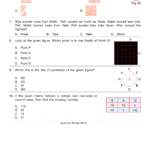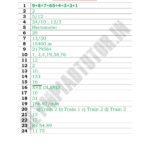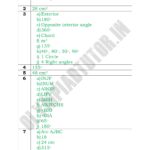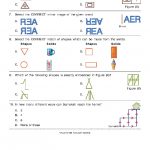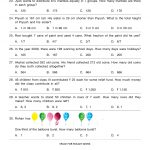Tag Archives: free maths worksheets
Class 5 : IMO papers
Class 4 : IMO papers
Class 5 Aryabhatta : Maths paper 2008 with answers
Solved Class V question paper of Aryabhata interschool maths competition 2008.
Solution
Vedic Maths: Completing the Whole
Let’s start from the basics. In arithmetic there are nine numbers and a 0. All the numbers are made using these. We need to understand the Place value of these numbers.
PLACE VALUE
We count numbers in groups of 10. Each place has a value of 10 times the place to its right.
Ten Units make a 10
Ten Tens make a 100
Ten Hundreds make a 1000 and so on…
In any number its value depends on its position/place.
In the number 2583: Value of 2 is 2000; 5 is 500; 8 is 80 and 3 is 3.
10 s: Group of 10 units/ones.
100s: Group of 10 tens
1000s: Group of 10 hundreds
10000: Group of 10 thousands
Ten Point Circle
If you look at the circle closely you will notice that the opposite numbers add to 10 (5 will add to itself and make 10)
Our number system is based on the number 10 and proceeds in cycles of 10 e.g. 10, 20, 30 and so on. The reason behind this is that compared to the other numbers; ‘10’ is a very easy number to handle.
Grade 4 Maths : Simple equations
Balance as a model of an equation
This article discusses how to use a balance to model simple linear equations in pre-algebra or algebra 1. On this page, we only deal with positive integers;
An equation is basically saying that two things (expressions, to be exact) are EQUAL. Since in a balanced situation the two sides of the balance hold equal weight, we can model simple equations with a balance.
In the pictures below, each circle represents one and the block represents the unknown x. To find out what the block weighs, you can
- add the same amount (circles or blocks) to BOTH sides
- take away the same amount from BOTH sides
That way both sides will maintain the balance or “the equality”.
|
x + 3 = 5 |
If this is a balanced situation… |
|
x = 2 |
…so is this! (We took away three circles from BOTH sides.) |

3x + 2 = 2x + 6 |
Take away two blocks (two x‘s) from both sides. The balance will stay balanced. |

x + 2 = 6 |
Take away 2 circles from both sides.The balance will stay balanced. |

x = 4 |
Here is the solution! |
Without the scale model, the solving process looks like this:
| 3x + 2 -2x |
= | 2x + 6 -2x |
(take away 2x from both sides) | |
| x + 2 -2 |
= | 6 -2 |
(take away 2 from both sides) | |
| x | = | 4 |
Dividing
In some situations you have to divide both sides of the equation by the same number. When is that? It’s in the fortunate situation where there are ONLY x’s (blocks) on one side but there are more than one.

2x = 8 |
If you take away half of the things on the left side, and similarly half of the things on the right side, the balance will stay balanced. |

x = 4 |

3x = 9 |
Think about it! If one is a balanced situation… |

x = 3 |
…so is the other (and vice versa)! We simply divided both sides by 3. |
Combining the operations
The allowed operations are:
- Add the same amount to both sides (either x‘s or ones)
- Subtract the same amount from both sides (either x‘s or ones)
- Multiply both sides by the same number (but not by zero)
- Divide both sides by the same number (but not by zero)
(There are others, too, but they are not needed in simple equations.)
The goal is to FIRST add and subtract until we have ONLY x‘s (blocks) on one side and ONLY ones (circles) on the other. Then, if you have more than one block, you need to divide so as to arrive to the situation with only one block on the one side, which is the solved equation!
Multiplying both sides can occur if you have a fractional block (less than one block) on one side. For example, the equation 1/4x = 13 is solved by multiplying both sides by 4. Try let your students model the equation 1/2x + 14 = 20 using a balance; they can solve it with it. More advanced students can ponder what to do about the equation 2/3x = 12.
Example of both subtracting and dividing
In this example we use all the abovementioned operations: taking away from both sides of the equation and dividing the equation by the same number.
 |
4x + 2 = 2x + 5First we get rid of the blocks on the right side by taking away two blocks from both sides.
2x + 2 = 5Then we eliminate the circles on the left side by removing 2 circles from both sides.
2x = 3Now there are only blocks on one side and only circles on the other. To find out what 1 block weighs, we take half of both sides.
x = 1 1/2The solution is that 1 block weighs 1 1/2 circles.
Try substituting this value x = 1 1/2 into the original equation 4x + 2 = 2x + 5 and check if the equation becomes true!
Example exercises
These equations are simple enough that you can solve them using a balance model. ALWAYS check your solution by substituting it into the original equation.
- 2x + 3 = 5
- 2x + 5 = x + 9
- 3x + 2 = 2x + 4
- 3x + 3 = 5 + x
- 5x + 4 = 3x + 6
- 6x + 2 = 3x + 6
- 6x + 3 = 2x + 5
IMO for Class 3 : Syllabus
Syllabus for Grade 3
- Comparing numbers
- Abacus and place value
- Word problems
Class 3 IMO : Papers
Grade 4 Maths (IMO) : Division
Let’s talk about what division really is — it is repeated subtraction; much the way multiplication is repeated addition.
Let’s say I have the basic problem 16 ÷ 4. I could start with 16 and then subtract 4, subtract another 4, another 4, and another 4 until I run out and reach zero. I would have to do this 4 times. If I had 16 cookies that I wanted to share equally among 4 friends, I could do the “one for you, one for you, one for you, and one for you” process and still end up with 4 cookies for each.
But what about 375 ÷ 50? If I don’t know how to divide by double digit numbers, the repeated subtraction process might actually be a good choice . . . at least showing some number sense to know that 375 divided by 50 means “How many 50’s in 375?” I know if I subtract 50 six times, I still have 75 left. I can subtract another 50 and I have 25 left over. So 375 ÷ 50 = 7 with a remainder of 25.
Dividing using the distributive law
| Division | Possible Split | Calculation | Answer |
| 69 ÷ 3 | 60 + 9 | (60 ÷ 3) = 20(9 ÷ 3) = 3 | 20 + 3 = 23 |
| 391 ÷ 3 | 390 + 1 | (390 ÷ 3) = 130(1 ÷ 3) = cannot be divided | 130 with Remainder 1 |
Long Division
Before a child is ready to learn long division, he/she has to know: Continue reading
Grade 3 Maths (IMO) : Number sense
Place value and Face value
Face value of a digit is the digit itself whereas Place value can be termed as the location of the digit in the numeral.
The value of a place in the place value chart is 10 times the value of the place just to its right.










